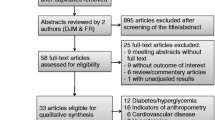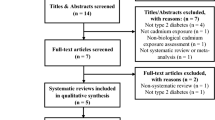Abstract
The present study was conducted to systematically review, analyze, and interpret all the relevant evidence in the literature on the possible link between exposure to bisphenol A (BPA) and the risk of type-2 diabetes mellitus (T2DM). We developed a comprehensive search strategy and used it to search Web of Science, Scopus, PubMed, and Google Scholar up to March 31, 2016, producing 3108 hits, of which 13 original papers were included. Findings of these studies were quite controversial; few studies indicated a significant positive association between BPA exposure and T2DM, while some other failed to detect such a relationship. Overall, it can be suggested that chance is unlikely the plausible explanation for the observed association between BPA exposure and T2DM. This was mainly because even in the negative studies some clues could be found in favor of a statistically significant relationship between BPA and T2DM. Additionally, some of the studies had shortcomings in defining the exposure and outcome measures, which, if present, might have led to underestimating the relationship between BPA exposure and T2DM. The theoretical plausibility of such a relationship found earlier in animal studies also supports this point. However, more definitive answer requires the conduct of future longitudinal studies, in which the possible association between BPA exposure and T2DM is assessed over much longer periods of time with more temporally robust BPA measurements. In addition, it would be quite beneficial if future studies be conducted in areas where data is still lacking (e.g., South America, Australia/Oceania, and Europe).

ᅟ

Similar content being viewed by others
References
Aekplakorn W, Chailurkit LO, Ongphiphadhanakul B (2015) Relationship of serum bisphenol A with diabetes in the Thai population, National Health Examination Survey IV, 2009. J Diabetes 7:240
Ahmadkhaniha R et al. (2014) Association of urinary bisphenol A concentration with type-2 diabetes mellitus. J Environ Health Sci Eng 12:64
Alonso-Magdalena P, Morimoto S, Ripoll C, Fuentes E, Nadal A (2006) The estrogenic effect of bisphenol A disrupts pancreatic β-cell function in vivo and induces insulin resistance. Environ Health Perspect 114:106
Alonso-Magdalena P, Vieira E, Soriano S, Menes L, Burks D, Quesada I, Nadal A (2010) Bisphenol A exposure during pregnancy disrupts glucose homeostasis in mothers and adult male offspring. Environ Health Perspect 118:1243
Alonso-Magdalena P et al. (2008) Pancreatic insulin content regulation by the estrogen receptor ERα. PLoS One 3:e2069
Andra SS, Kalyvas H, Andrianou XD, Charisiadis P, Christophi CA, Makris KC (2015) Preliminary evidence of the association between monochlorinated bisphenol A exposure and type II diabetes mellitus: a pilot study. J Environ Sci Health A Tox Hazard Subst Environ Eng 50:243–259. doi:10.1080/10934529.2015.981111
Arenholt-Bindslev D, Breinholt V, Preiss A, Schmalz G (1999) Time-related bisphenol-A content and estrogenic activity in saliva samples collected in relation to placement of fissure sealants. Clin Oral Invest 3:120–125
Barker DJ (1998) In utero programming of chronic disease. Clin Sci 95:115–128
Barker DJ, Eriksson JG, Forsen T, Osmond C (2002) Fetal origins of adult disease: strength of effects and biological basis. Int J Epidemiol 31:1235–1239
Ben-Jonathan N, Hugo ER, Brandebourg TD (2009) Effects of bisphenol A on adipokine release from human adipose tissue: implications for the metabolic syndrome. Mol Cell Endocrinol 304:49–54
Braun JM et al. (2011) Variability and predictors of urinary bisphenol A concentrations during pregnancy. Environ Health Perspect 119:131
Burridge E (2003) Bisphenol A: product profile. Eur Chem News 78:17
Calafat AM, Kuklenyik Z, Reidy JA, Caudill SP, Ekong J, Needham LL (2005) Urinary concentrations of bisphenol A and 4-nonylphenol in a human reference population. Environ Health Perspect 113:391
Calafat AM, Ye X, Wong L-Y, Reidy JA, Needham LL (2008) Exposure of the US population to bisphenol A and 4-tertiary-octylphenol: 2003–2004. Environ Health Perspect 116:39
Casey MF, Neidell M (2013) Disconcordance in statistical models of bisphenol a and chronic disease outcomes in NHANES 2003-08. PLoS One 8(11):e79944
Dekant W, Völkel W (2008) Human exposure to bisphenol A by biomonitoring: methods, results and assessment of environmental exposures. Toxicol Appl Pharmacol 228:114–134
Howe SR, Borodinsky L, Lyon RS (1998) Potential exposure to bisphenol A from food-contact use of epoxy coated cans. J Coat Tech 70:69–74
Hugo ER, Brandebourg TD, Woo JG, Loftus J, Alexander JW, Ben-Jonathan N (2008) Bisphenol A at environmentally relevant doses inhibits adiponectin release from human adipose tissue explants and adipocytes. Environ Health Perspect 116:1642–1647
Khan KS, Kunz R, Kleijen J, Antes G (2003) Systematic reviews to support evidence-based medicine: how to write and apply findings of healthcare research. Royal Society of Medicine Press, London
Kim K, Park H (2013) Association between urinary concentrations of bisphenol A and type 2 diabetes in Korean adults: a population-based cross-sectional study. Int J Hygiene Environ Health 216:467–471
Kuo C-C, Moon K, Thayer KA, Navas-Acien A (2013) Environmental chemicals and type 2 diabetes: an updated systematic review of the epidemiologic evidence. Curr Diab Rep 13:831–849. doi:10.1007/s11892-013-0432-6
LaKind JS, Goodman M, Mattison DR (2014) Bisphenol A and indicators of obesity, glucose metabolism/type 2 diabetes and cardiovascular disease: a systematic review of epidemiologic research. Crit Rev Toxicol 44:121–150. doi:10.3109/10408444.2013.860075
LaKind JS, Goodman M, Naiman DQ (2012) Use of NHANES data to link chemical exposures to chronic diseases: a cautionary tale. PLoS One 7:e51086
Lang IA, Galloway TS, Scarlett A, Henley WE, Depledge M, Wallace RB, Melzer D (2008) Association of urinary bisphenol A concentration with medical disorders and laboratory abnormalities in adults. JAMA 300:1303–1310
Livingstone C, Collison M (2002) Sex steroids and insulin resistance. Clin Sci 102:151–166
Loganathan SN, Kannan K (2011) Occurrence of bisphenol A in indoor dust from two locations in the eastern United States and implications for human exposures. Arch Environ Contam Toxicol 61:68–73
Louet J-F, LeMay C, Mauvais-Jarvis F (2004) Antidiabetic actions of estrogen: insight from human and genetic mouse models. Curr Atheroscleros Rep 6:180–185
Melzer D, Rice NE, Lewis C, Henley WE, Galloway TS (2010) Association of urinary bisphenol A concentration with heart disease: evidence from NHANES 2003/06. PLoS One 5:e8673
Nadal A, Alonso-Magdalena P, Soriano S, Quesada I, Ropero AB (2009a) The pancreatic β-cell as a target of estrogens and xenoestrogens: implications for blood glucose homeostasis and diabetes. Mol Cell Endocrinol 304:63–68
Nadal A, Alonso-Magdalena P, Soriano S, Ropero AB, Quesada I (2009b) The role of oestrogens in the adaptation of islets to insulin resistance. J Physiol 587:5031–5037
Ning G et al. (2011) Relationship of urinary bisphenol A concentration to risk for prevalent type 2 diabetes in Chinese adults: a cross-sectional analysis. Ann Intern Med 155:368–374
Rancière F, Lyons JG, Loh VHY, Botton J, Galloway T, Wang T, Shaw JE, Magliano DJ (2015) Bisphenol A and the risk of cardiometabolic disorders: a systematic review with meta-analysis of the epidemiological evidence. Environ Health 14:46
Ropero AB, Alonso-Magdalena P, Quesada I, Nadal A (2008) The role of estrogen receptors in the control of energy and glucose homeostasis. Steroids 73:874–879
Sabanayagam C, Teppala S, Shankar A (2013) Relationship between urinary bisphenol A levels and prediabetes among subjects free of diabetes. Acta Diabetol 50:625–631. doi:10.1007/s00592-013-0472-z
Sajiki J, Yonekubo J (2003) Leaching of bisphenol A (BPA) to seawater from polycarbonate plastic and its degradation by reactive oxygen species. Chemosphere 51:55–62
Shankar A, Teppala S (2011) Relationship between urinary bisphenol A levels and diabetes mellitus. The J Clin Endocrinol Metabol 96:3822–3826
Silver MK, O’Neill MS, Sowers MR, Park SK (2011) Urinary bisphenol A and type-2 diabetes in US adults: data from NHANES 2003-2008. PLoS One 6:e26868
Song Y, Chou EL, Baecker A, You NCY, Song Y, Sun Q, Liu S (2015) Endocrine-disrupting chemicals, risk of type 2 diabetes, and diabetes-related metabolic traits: a systematic review and meta-analysis. J Diabet. doi:10.1111/1753-0407.12325
Sowlat MH, Abdollahi M, Gharibi H, Yunesian M, Rastkari N (2014) Removal of vapor-phase elemental mercury from stack emissions with sulfur-impregnated activated carbon. In: Rev Environ Contam Toxicol volume. Springer, pp 1–34
Sun Q et al. (2014) Association of urinary concentrations of bisphenol A and phthalate metabolites with risk of type 2 diabetes: a prospective investigation in the nurses’ health study (NHS) and NHSII cohorts. Environ Health Perspect 122:616–623
Sutton AJ, Abrams KR, Jones DR, Sheldon TA, Song F (2000) Methods for meta-analysis in medical research. J. Wiley,
Tang W-y, Ho S-m (2007) Epigenetic reprogramming and imprinting in origins of disease. Rev Endocr Metabol Disord 8:173–182
Trujillo M, Scherer P (2005) Adiponectin–journey from an adipocyte secretory protein to biomarker of the metabolic syndrome. J Intern Med 257:167–175
Tsai W-T (2006) Human health risk on environmental exposure to bisphenol-A: a review. J Environ Sci Health C 24:225–255
Tu Y-K, Greenwood DC (2012) Modern methods for epidemiology. Springer
Vandenberg L, Chahoud I, Heindel JJ, Padmanabhan V, Paumgartten FJ, Schoenfelder G (2010) Urinary, circulating, and tissue biomonitoring studies indicate widespread exposure to bisphenol A. Environ Health Perspect 118:1055–1070
Vandenberg LN, Hauser R, Marcus M, Olea N, Welshons WV (2007) Human exposure to bisphenol A (BPA). Reprod Toxicol 24:139–177
Vandenberg LN, Maffini MV, Sonnenschein C, Rubin BS, Soto AM (2009) Bisphenol-A and the great divide: a review of controversies in the field of endocrine disruption. Endocr Rev 30:75–95
Whitehead J, Richards A, Hickman I, Macdonald G, Prins J (2006) Adiponectin—a key adipokine in the metabolic syndrome. Diab Obes Metabol 8:264–280
Ye X, Wong L-Y, Bishop AM, Calafat AM (2011) Variability of urinary concentrations of bisphenol A in spot samples, first morning voids, and 24-h collections. Environ Health Perspect 119:983
Acknowledgment
The present study was financially supported by the Institute for Environmental Research (IER), Tehran University of Medical Sciences (TUMS).
Author information
Authors and Affiliations
Corresponding author
Additional information
Responsible editor: Philippe Garrigues
Rights and permissions
About this article
Cite this article
Sowlat, M.H., Lotfi, S., Yunesian, M. et al. The association between bisphenol A exposure and type-2 diabetes: a world systematic review. Environ Sci Pollut Res 23, 21125–21140 (2016). https://doi.org/10.1007/s11356-016-7525-0
Received:
Accepted:
Published:
Issue Date:
DOI: https://doi.org/10.1007/s11356-016-7525-0




